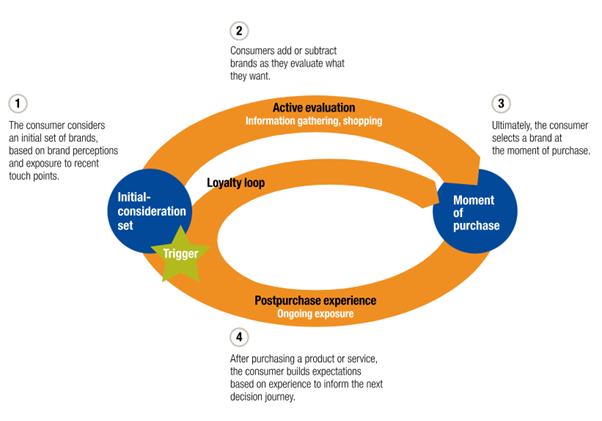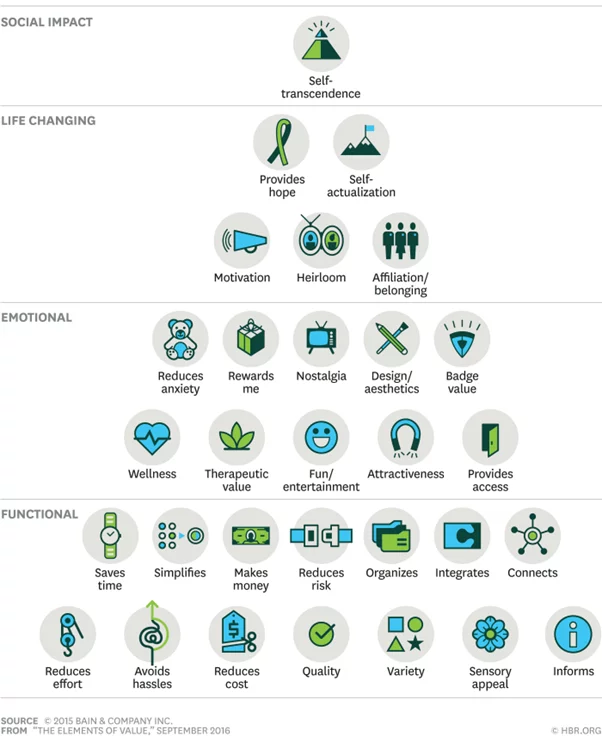What do your customers value? Unpacking the Elements of Value Pyramid
A lot of thinking goes into the purchase decision-making process beyond price. Consumer evaluation comprising of a multitude of factors; from organisation-driven marketing and past experience to word of mouth and dealer interactions, yet recent studies have shown that when a customer evaluates a product to purchase, “a products perceived values play one of, if not the most important role in this process.”

As David Court et al., surmises in their article ‘The consumer decision journey’ “if marketing has one goal, it’s to reach consumers at the moments that most influence their decisions.” Understanding the importance of perceived product value in this process, it is therefore critical to identify what it is that consumers value most about a given product. However, what customers truly value “can be difficult to pin down and psychologically complicated.”
The Customer Value Pyramid is a conceptual framework introduced by the Harvard Business Review (HBR) in 2016 that seeks to overcome this barrier. The pyramid consists of 30 distinct elements categorised into four tiers, each representing a different level of product importance to customers. These elements go beyond the traditional view of value, extending beyond basic functional attributes and delving into the emotional, life-changing, and social aspects that influence customer preferences. Their research importantly describes that:
“A rigorous model of consumer value allows a company to come up with new combinations of value that its products and services could deliver. The right combinations, our analysis shows, pay off in stronger customer loyalty, greater consumer willingness to try a particular brand, and sustained revenue growth.”

Ultimately, the Customer Value Pyramid serves as a strategic guide for businesses aiming to enhance their value proposition and deepen their connection with customers. By understanding and leveraging the 30 elements, companies can craft products and services that resonate on multiple levels, creating a more compelling and differentiated offering in the market, hopefully allowing for greater conversion in the critical product evaluation moments.
In order to implement, it is first vital to unpack the pyramid. Each tier can be thought of as such:
Functional Values (Base of the Pyramid):
- Definition: Functional values are the foundational elements that fulfill a customer’s basic, utilitarian needs.
- How it works: These are the fundamental attributes that customers expect from a product or service. Meeting these basic requirements is essential for a business to be competitive.
Emotional Values (Second Tier):
- Definition: Emotional values tap into the customer’s feelings and experiences, creating a more personal connection.
- How it works: Emotional values foster a deeper relationship between the customer and the brand. Positive emotions, such as trust or joy, contribute to brand loyalty and a positive customer experience.
Life-Changing Values (Third Tier):
- Definition: Life-changing values go beyond the functional and emotional to contribute to personal or professional growth.
- How it works: These values have a transformative impact on the customer’s life, providing a sense of fulfillment and contributing to personal development. They can lead to long-term customer loyalty and advocacy.
Social Impact Values (Top of the Pyramid):
- Definition: Social impact values extend beyond individual customers to contribute positively to society.
- How it works: Businesses that prioritize social impact values align themselves with broader societal concerns. This can attract socially conscious consumers and enhance the brand’s reputation, creating a positive image and contributing to long-term success.
To apply elements of the pyramid within an organisation, its likely you’ll undertake three key steps:
- Identification: Identify which specific elements within each tier are most relevant to their target audience. This can be aided through deep customer understanding and research.
- Integration: Once identified, these elements can be integrated into the product or service offerings, marketing strategies, and overall brand positioning.
- Customisation: The framework allows for customisation based on the industry, market, and target customer segment. Not all elements are equally important for every business.
To help businesses in their journey, HBR highlights that what customers value in products varies by industry and offer a look at the top five elements influencing loyalty for 10 types of businesses:
|
|
|
|
|
|
|
|
|
|
| From “THE ELEMENTS OF VALUE,” SEPTEMBER 2016 | © HBR.ORG |
The research shows that “the higher the elements you choose and deliver, the faster you’ll be able to grow and have profit. But it’s important to understand that to be able to deliver on these higher-order elements; you first need to have a strong foundation and provide at least some of the functional elements. If those basic values aren’t met, you can’t make an emotional and psychological connection with your customer. For example, the classic single speed bike can only give its customers a nostalgic feeling because it already checks the quality element.” – Amado, 2019
In essence, the Elements of Value pyramid is a strategic tool that helps businesses systematically analyse, enhance, and communicate the value they provide to customers. By leveraging the diverse elements and better understanding what customers value, businesses can create a more nuanced and compelling value proposition that resonates with customers on various levels, fostering long-term loyalty and sustainable success in the competitive market.




